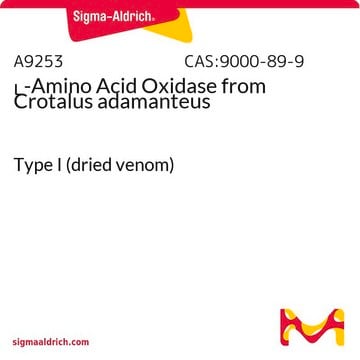S3132
Seleno-L-methionine
≥98% (TLC), powder, IgE expression inhibitor
Sinónimos:
(S)-2-Amino-4-(methylseleno)butyric acid
About This Item
Productos recomendados
product name
Seleno-L-methionine, ≥98% (TLC), powder
assay
≥98% (TLC)
form
powder
color
white to off-white
solubility
H2O: 50 mg/mL
storage temp.
−20°C
SMILES string
C[Se]CC[C@H](N)C(O)=O
InChI
1S/C5H11NO2Se/c1-9-3-2-4(6)5(7)8/h4H,2-3,6H2,1H3,(H,7,8)/t4-/m0/s1
InChI key
RJFAYQIBOAGBLC-BYPYZUCNSA-N
¿Está buscando productos similares? Visita Guía de comparación de productos
General description
Application
- in toxicity studies in Japanese Medaka embryos
- to study its effects on selenium status indicators in pregnant long-tailed macaques (Macaca Fascicularis)
- to label proteins for single wavelength anomalous dispersion (SAD) phasing
- as a nonchemical stressor to treat Japanese Medaka fish embryos
- to label proteins for Single wavelength Anomalous Dispersion (SAD) phasing
- to study the distribution and inhibition effects of seleno-L-methionine on 4T1 mouse mammary carcinoma
Biochem/physiol Actions
signalword
Danger
hcodes
Hazard Classifications
Acute Tox. 3 Inhalation - Acute Tox. 3 Oral - Aquatic Acute 1 - Aquatic Chronic 1 - STOT RE 2
Storage Class
6.1A - Combustible acute toxic Cat. 1 and 2 / very toxic hazardous materials
wgk_germany
WGK 3
flash_point_f
250.3 - 346.3 °F
flash_point_c
121.3 - 174.6 °C
Certificados de análisis (COA)
Busque Certificados de análisis (COA) introduciendo el número de lote del producto. Los números de lote se encuentran en la etiqueta del producto después de las palabras «Lot» o «Batch»
¿Ya tiene este producto?
Encuentre la documentación para los productos que ha comprado recientemente en la Biblioteca de documentos.
Los clientes también vieron
Artículos
Antioxidants protect biological systems from oxidative damage produced by oxygen-containing free radicals and from redoxactive transition metal ions such as iron, copper, and cadmium.
Nuestro equipo de científicos tiene experiencia en todas las áreas de investigación: Ciencias de la vida, Ciencia de los materiales, Síntesis química, Cromatografía, Analítica y muchas otras.
Póngase en contacto con el Servicio técnico













